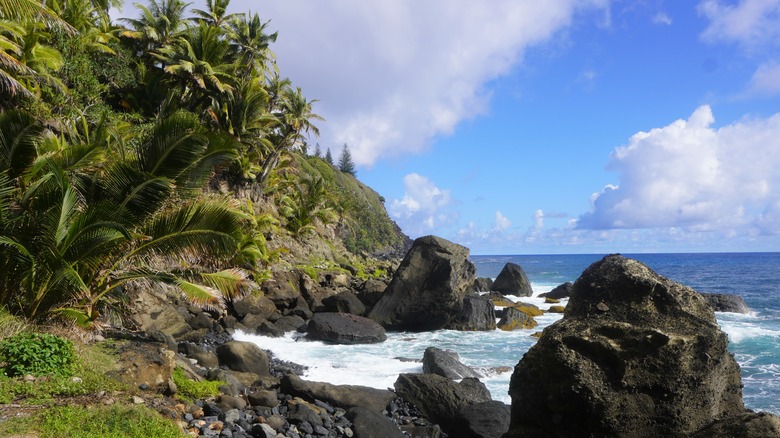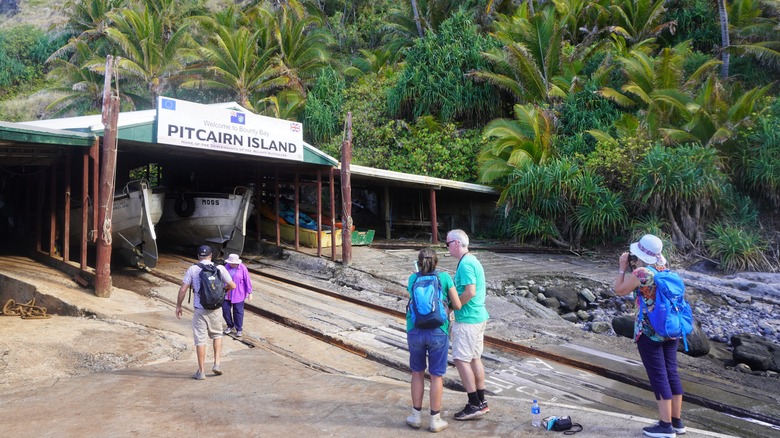These Remote Islands Are An Incredible Destination For Adventure Seeking Travelers
Don't you sometimes feel the urge to get away from it all? For intrepid travelers seeking total isolation, Point Nemo in the Pacific Ocean is officially the farthest point from land. It is a place so remote that if you managed to get there, astronauts on the International Space Station would be closer to the rest of humanity than you. By definition, however, Point Nemo isn't much of a vacation destination as it is just an invisible point in the ocean. For a more rewarding experience with people to meet and things to see and do, your best bet is to find your way to one of Point Nemo's closest land-based neighbors: the Pitcairn Islands, around 1,670 miles north.
Situated a mere 3,240 miles from the coast of New Zealand, the archipelago consists of four far-flung islands of which only one, Pitcairn, is populated. It is one of the most remote islands on the planet and the capital, Adamstown, has a population of less than 50 people. Seeking out this subtropical paradise so far away from everywhere else is a huge part of the appeal of traveling to the Pitcairn Islands and getting there in the first place is a big part of the adventure. So how do you reach such a remote spot and what can you do once you get there?
How do you get to the Pitcairn Islands?
Situated so far away in the middle of the Pacific Ocean, it is remarkable that anyone can live on the islands at all. Yet there is archaeological evidence to show that Polynesian people inhabited the islands long before its most famous residents staked a claim in 1790: Fletcher Christian and his mutineers from the HMS Bounty. Accompanied by their Tahitian consorts and on the run for overthrowing the command of Captain William Bligh, the crew burned the ship and settled in for a new life. Many of the people who live on Pitcairn Island are descendants of the mutineers and speak a local dialect called Pitkern, a blend of Tahitian and 18th-century English.
With no airport, getting to the Pitcairn Islands is no easy feat. One way is booking a berth on the islands' chartered supply vessel, the Silver Supporter, which transports goods to Pitcairn. As a working ship, it can only accommodate 12 passengers for the 32-hour voyage from Mangareva in French Polynesia. It isn't cheap – berths cost around $3,200 per person. Another way to get there is to find a cruise that is scheduled to stop by, but only around 10 to 15 ships visit each season.
You might be thinking it would be cheaper and easier to buy a yacht and sail there yourself. Currently around 25 yachts each year make the journey and these determined sailors receive a warm welcome from the islanders.
Things to do in the Pitcairn Islands
For an island only two miles long and a mile wide, there are many activities and things to see during your stay. This is because Pitcairn is abundant in both nature and history. Surrounded by pristine ocean and coral reefs, the Pitcairn Islands are home to one of the largest marine reserves on the planet, so snorkeling and diving are great ways to experience the archipelago's rich biodiversity. Most spectacular are the humpback whales who visit the islands for breeding and calvingfrom May to October. When the sun goes down, you will get one of the best opportunities for stargazing in your life; with zero light pollution, the island group is designated as an International Dark Sky Sanctuary.
Among all the luscious vegetation on the island, there are important reminders of Pitcairn's remarkable human history. With the help of a guide, you can descend a cliff known as Down Rope to see ancient carvings from the Polynesian people who once populated the island. Elsewhere, you can visit the grave of John Adams, the last surviving mutineer, and the Pitcairn Museum with its artifacts ranging from Polynesian tools to relics from the Bounty.
As you'd imagine for an isolated island with a small population, Pitcairn isn't the kind of place to come to if you want to keep yourself to yourself. Visitors are welcomed into the community during their stay and, once you depart, you'll be leaving a lot of new friends behind.


